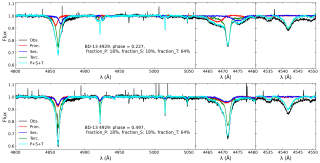In a recently published differential analysis (see ApJ, 724, 1536, Dec. 1 issue) , we have derived abundance corrections for iron lines, using synthetic spectra from solar magnetoconvection simulations that were performed via running the Copenhagen stagger-code on massively-parallel clusters. The series of 3D snapshots used for the spectral synthesis covers 2.5 solar hours in the statistically stationary regime of the convection.
Crucially, we show that the effect of magnetic fields on solar abundance
determinations can not be neglected. This is equally valid for all three different Fe abundance indicators which we have studied, though the sign of the abundance correction changes depending on the interplay of the magnetic-sensitivity of the spectral line underconsideration and of temperature structure variations.
Interestingly, for two of the abundance indicators (respectively, at 608.27
nm and 624.07 nm) that were used in Asplund et al\'s (2000 A&A, 359,
743) analysis and that we also included in our investigation, the presence of amagnetic field has a predominantly indirect (i.e., due to temperature changes between MHD and HD models) effect, leading to positive abundance corrections (since the final equivalent width of those Fe I lines is found to decrease with increasing magnetic flux). The direct magnetic effect due to Zeeman broadening dominates instead for the 1564.85 nm absorption line, causing for it increasingly negative abundance corrections when making the initially implanted magnetic flux larger.
Keywords: magnetohydrodynamics (MHD); radiative transfer; Sun: abundances, granulation, photosphere
Advertised on
References
(2010) Solar abundance corrections derived throughthree-dimensional magneto convection simulations. ApJ, Volume 724, 2, pp. 1536-1541


